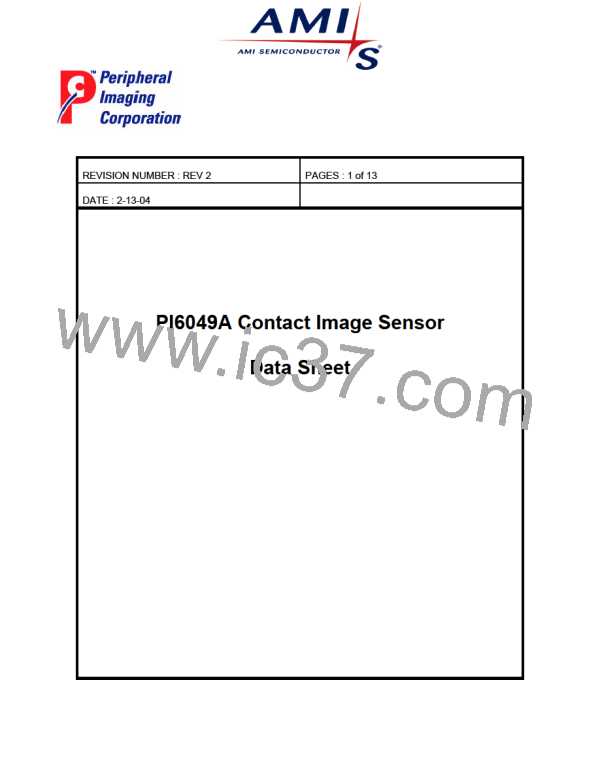PI6049A Data Sheet
__________________________________________________________________________________________
PI6049A Unique Features
There are five unique features incorporated in the PI6049A which improve the sensor’s performance.
1. Pixel-to-Pixel Offset Cancellation Circuit
The sensor employs a pixel-to-pixel offset cancellation circuit, which reduces the Fix Pattern Noise (FPN), and
amplifier offsets. In addition, this innovative circuit design greatly improves the optical linearity and low noise
sensitivity.
2. Parallel Integrate, Transfer and Hold
The sensor has a parallel integrate, transfer and hold feature, which allows the sensor to be read out while photon
integration is taking place. These features are approached through the use of an integrate and hold cell, located
at each pixel site. Each pixel’s charge is read from its storage site as the sensor’s shift register sequentially
transfers each pixel’s charge onto a common video line.
3. Dual Scan Initiation Inputs, GBST and SI
Each sensor has two scan initiation inputs, the Global Start Pulse (GBST) and the Start Pulse (SI). These clocks
help to reduce the sensor-to-sensor transition Fix Pattern Noise by initializing and preprocessing all sensors
simultaneously before they start their readout scan. The internal shift register starts the scan after GBST is
clocked in on the falling edge of the Clock input (CLK).
The Start Input Control (SIC) selects the first sensor in a sequence of cascaded sensors to operate with 29 clock
cycles of delay by connecting it to Vdd on the first sensor, and to Ground for all subsequent sensors. Then, only
the first sensor clocks out 29 inactive pixels before accessing its first active pixel. During these 29 clock cycles,
the first sensor and all of the subsequent cascaded sensors cycle through their pre-scan initialization process.
After initialization, only the first sensor starts its read cycle with its first-active pixel appearing on the 30th clock
cycle. The second and subsequent sensors await the entry of their Start Pulse (SI). Furthermore, the first sensor’s
Start Pulse (SI) is left unconnected, while the subsequent sensors all have their Start Pulse’s (SI) connected to
the SO of their respective preceding sensor. The external scan Start Pulse (SI) is connected to all of the sensors'
Global Start Pulse (GBST) inputs.
As the first sensor completes its scan, its End-of-Scan (SO), appears 1 pixel before its last pixel. The second and
subsequent sensors will then start their registers 1 clock cycle before the appearance of their respective first
pixels, and their SO also appears 1 pixel before their last pixel.
4. Power Saving
Each sensor incorporates a power-saving feature when multiple sensors are cascaded together to form a linear
imaging array. The Start Input Control (SIC) on each sensor selects a unique feature of powering up a particular
sensor’s output amplifier when it’s selected and powering it down when not selected. For the PI6049A, only the
first sensors’ amplifier is used and all subsequent sensors have their amplifiers turned off. The pixels from each
sensor are transferred onto a common video line which is connected to the amplifier of the first sensor. The
advantage of using only one active amplifier is two fold; saving on power consumption and reducing sensor-to-
sensor FPN.
5. Common Reference Voltage between Cascaded Sensors
Each sensor has an input/output bias control (VR), which serves as an offset voltage reference. Each bias control
pad is connected to an internal bias source and tied to its own amplifier’s reference bias input. In operation, these
pads on every sensor are connected together. Each sensor then “shares” the same bias level to maintain a
constant bias among all of the sensors.
Page 3 of 13, Revised 2-13-04

 AMI [ AMI SEMICONDUCTOR ]
AMI [ AMI SEMICONDUCTOR ]